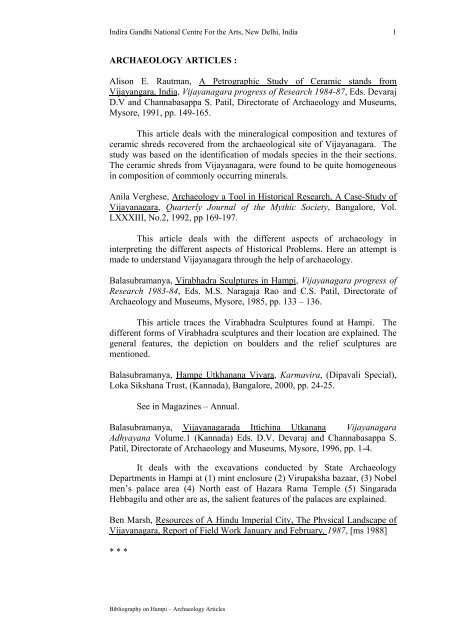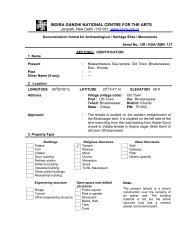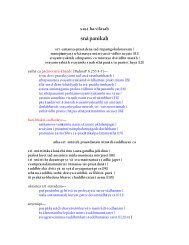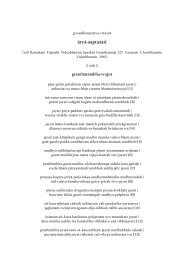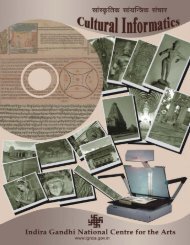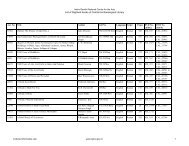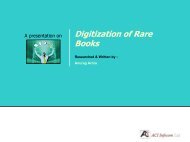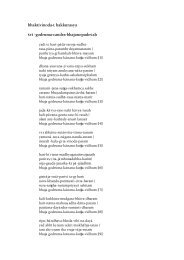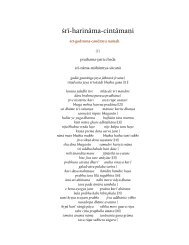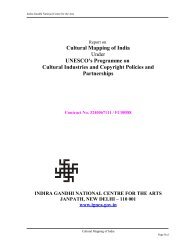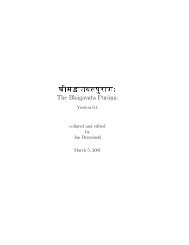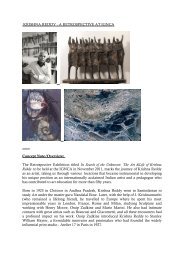sdfsf sf - Indira Gandhi National Centre for the Arts
sdfsf sf - Indira Gandhi National Centre for the Arts
sdfsf sf - Indira Gandhi National Centre for the Arts
You also want an ePaper? Increase the reach of your titles
YUMPU automatically turns print PDFs into web optimized ePapers that Google loves.
<strong>Indira</strong> <strong>Gandhi</strong> <strong>National</strong> <strong>Centre</strong> For <strong>the</strong> <strong>Arts</strong>, New Delhi, India<br />
ARCHAEOLOGY ARTICLES :<br />
Alison E. Rautman, A Petrographic Study of Ceramic stands from<br />
Vijayangara, India, Vijayanagara progress of Research 1984-87, Eds. Devaraj<br />
D.V and Channabasappa S. Patil, Directorate of Archaeology and Museums,<br />
Mysore, 1991, pp. 149-165.<br />
This article deals with <strong>the</strong> mineralogical composition and textures of<br />
ceramic shreds recovered from <strong>the</strong> archaeological site of Vijayanagara. The<br />
study was based on <strong>the</strong> identification of modals species in <strong>the</strong> <strong>the</strong>ir sections.<br />
The ceramic shreds from Vijayanagara, were found to be quite homogeneous<br />
in composition of commonly occurring minerals.<br />
Anila Verghese, Archaeology a Tool in Historical Research, A Case-Study of<br />
Vijayanagara, Quarterly Journal of <strong>the</strong> Mythic Society, Bangalore, Vol.<br />
LXXXIII, No.2, 1992, pp 169-197.<br />
This article deals with <strong>the</strong> different aspects of archaeology in<br />
interpreting <strong>the</strong> different aspects of Historical Problems. Here an attempt is<br />
made to understand Vijayanagara through <strong>the</strong> help of archaeology.<br />
Balasubramanya, Virabhadra Sculptures in Hampi, Vijayanagara progress of<br />
Research 1983-84, Eds. M.S. Naragaja Rao and C.S. Patil, Directorate of<br />
Archaeology and Museums, Mysore, 1985, pp. 133 – 136.<br />
This article traces <strong>the</strong> Virabhadra Sculptures found at Hampi. The<br />
different <strong>for</strong>ms of Virabhadra sculptures and <strong>the</strong>ir location are explained. The<br />
general features, <strong>the</strong> depiction on boulders and <strong>the</strong> relief sculptures are<br />
mentioned.<br />
Balasubramanya, Hampe Utkhanana Vivara, Karmavira, (Dipavali Special),<br />
Loka Sikshana Trust, (Kannada), Bangalore, 2000, pp. 24-25.<br />
See in Magazines – Annual.<br />
Balasubramanya, Vijayanagarada Ittichina Utkanana Vijayanagara<br />
Adhyayana Volume.1 (Kannada) Eds. D.V. Devaraj and Channabasappa S.<br />
Patil, Directorate of Archaeology and Museums, Mysore, 1996, pp. 1-4.<br />
It deals with <strong>the</strong> excavations conducted by State Archaeology<br />
Departments in Hampi at (1) mint enclosure (2) Virupaksha bazaar, (3) Nobel<br />
men’s palace area (4) North east of Hazara Rama Temple (5) Singarada<br />
Hebbagilu and o<strong>the</strong>r are as, <strong>the</strong> salient features of <strong>the</strong> palaces are explained.<br />
Ben Marsh, Resources of A Hindu Imperial City, The Physical Landscape of<br />
Vijayanagara, Report of Field Work January and February, 1987, [ms 1988]<br />
* * *<br />
Bibliography on Hampi – Archaeology Articles<br />
1
<strong>Indira</strong> <strong>Gandhi</strong> <strong>National</strong> <strong>Centre</strong> For <strong>the</strong> <strong>Arts</strong>, New Delhi, India<br />
Bernard K. Means, A small settlement near <strong>the</strong> city of Vijayanagara,<br />
Vijayanagara Progress of Research 1987-88. Eds. D.V. Devaraj and<br />
Chennabasappa S.Patil, Directorate of Archaeology and Museums, Mysore,<br />
1991, pp. 154-164.<br />
This article explains <strong>the</strong> Vijayanagara period settlement near<br />
Venkatapura. This settlement covers <strong>the</strong> eastern slope of <strong>the</strong> out crop and low<br />
laying area at its base. This settlement is a part of <strong>the</strong> imperial capital in <strong>the</strong><br />
metropolitan region.<br />
Carla M. Sinopoli, Vijayanagara Ceramic analysis, 1983-84, progress report<br />
Vijayanagara progress of Research 1983-84, Eds. M.S. Nagaraja Rao, and<br />
C.S.Patil, Directorate of Archaeology and Museums, Mysore, 1985,<br />
pp. 57-69.<br />
This article deals with <strong>the</strong> ear<strong>the</strong>nware pottery found in <strong>the</strong> Noble<br />
men’s palaces 1 and 2. Here <strong>the</strong> importance is given to technological and<br />
functional aspects and also <strong>the</strong> distribution of ceramic <strong>for</strong>ms across <strong>the</strong> site.<br />
Carla M. Sinopoli, The Ear<strong>the</strong>nware Pottery of <strong>the</strong> Royal Enclosures of<br />
Vijayanagara, South India, Report on <strong>the</strong> Excavations in <strong>the</strong> Royal Enclosures<br />
of Vijayanagara (tentative title), Ed. M.S. Nagaraja Rao, pp. -Archaeological<br />
Survey of India, NEW DELHI . [ms 1986].<br />
***<br />
Carla M. Sinopoli, Vijayanagara, Ceramics. The 1986 field season,<br />
Vijayangara progress of research 1984-87. Eds. Devaraj D.V. and<br />
Channapasappa S. Patil, Directorate of Archaeology and Museums, Mysore,<br />
1991 pp. 97-104.<br />
This article discuss in detail about <strong>the</strong> analysis of ceramics found at<br />
Noblemen quarters. Islamic quarters, eastern valley. In Noblemen’s area<br />
through ceramics, many places like <strong>the</strong> cooking area, food storage area or<br />
serving areas and <strong>the</strong> refuse deposit areas are identified.<br />
Carla M Sinopoli, The Local Pottery of Vijayanagara, Research, Perspectives<br />
and Preliminary Results. South Asian Archaeology, 1983, Eds. M. Taddei and<br />
J. Schotsmans, Instituto Universitario Orientale, Dipartimento di Studi<br />
Asatici, Naples, Series Minor XXIII, 885-900. 1985 c.<br />
* * *<br />
Carla M. Sinopoli, (a) The Par<strong>the</strong>n Pottery of Vijayanagara Documentation<br />
and interpretation. Ed. Anna L. Dallapiccola, Stuttgart, Franz Steiner,<br />
Verlong Wiesbanden, GMBH, 1985, pp. 216-228, 229-239.<br />
This article deals with pottery, and explains how it contributes to <strong>the</strong><br />
knowledge of economic, spatial and social organization of <strong>the</strong> city. The social<br />
organization of <strong>the</strong> city is also discussed.<br />
Bibliography on Hampi – Archaeology Articles<br />
2
<strong>Indira</strong> <strong>Gandhi</strong> <strong>National</strong> <strong>Centre</strong> For <strong>the</strong> <strong>Arts</strong>, New Delhi, India<br />
Carla M. Sinopoli and T.Richard Blurton, Contemporary Pottery Production<br />
in Kamalapuram, South India Dimensions of Indian Art, Pupul Jayakar<br />
Seventy, Eds. L. Chandra and J. Jain, Vol. 1, Agam Kala Prakashan, New<br />
Delhi, 1986, pp. 439-456.<br />
* * *<br />
Carl M. Sinopoli, Approaches to Ceramic Studies in Archaeology, The<br />
Ceramics of Vijayanagara, South India. (ms 1987).<br />
* * *<br />
Carl M. Sinopoli, Approaches to Archaeological Ceramic. New York, Plenum<br />
Press, (includes discussion of her Vijayanagara ceramic research, pp. 62-64,<br />
91-97) 1991.<br />
* * *<br />
Carla M. Sinopoli, The Organisation of Craft Production at Vijayanagara,<br />
South India American Anthropologist 90, 580-597, 1988.<br />
* * *<br />
Carla M. Sinopoli, Standardization and Specialization, Ceramic Production at<br />
Vijayanagara, South India Old Problems – New Perspectives in <strong>the</strong><br />
Archaeology of South Asia , Ed. J. Mark Kenoyer, University of Wisconsin<br />
Press, Madison, 1989, pp. 263-272.<br />
* * *<br />
Carla M Sinopoli, The Ceramics of <strong>the</strong> Noblemen’s Quarter of Vijayanagara,<br />
South Asian Archaeology, 1987, M. Taddei, Ed. Roma, Instituto Italiano per<br />
il Medio ed Estremo Oriente (ISMEO). Serie Orientale Roma, 2, vol. LXVI,<br />
1990, pp. 1127-1150.<br />
* * *<br />
Carla M. Sinopoli, The Ear<strong>the</strong>rnware Pottery of Vijayanagara, some<br />
observations, Vijayanagara Progress of Research, 1979-83, Directorate of<br />
Archaeology and Museums, Mysore, 1983, pp. 68-74.<br />
This article deals with <strong>the</strong> pottery, which had not received great<br />
attention. The organization of ceramic productions and distributions at <strong>the</strong><br />
site and <strong>the</strong> workshops in which <strong>the</strong> vessels were made are discussed. The<br />
production Techniques, <strong>the</strong> Variety of wares, vessel <strong>for</strong>ms and decorative<br />
treatment are taken note off during <strong>the</strong> study of ceramics.<br />
Bibliography on Hampi – Archaeology Articles<br />
3
<strong>Indira</strong> <strong>Gandhi</strong> <strong>National</strong> <strong>Centre</strong> For <strong>the</strong> <strong>Arts</strong>, New Delhi, India<br />
Carla M. Sinopoli, Vijayanagara Ceramics: The 1986 Field Season,<br />
Vijayanagara, Progress of Research, 1984-1987, Eds. D.V. Devaraja and<br />
Channabasappa S. Patil, Directorate of Archaeology and Museums, Mysore<br />
1991, pp.97-104.<br />
This article discusses in detail about <strong>the</strong> analysis of ceramics found at<br />
Noblemen’s and Islamic quarters. In Noblemen’s area though ceramics found<br />
at various places some are identify as cooking area, food storage area and<br />
refuse deposit area etc.<br />
Carla M. Sinopoli and Kathlean D. Morrision, The Vijayanagara<br />
Metropolitan Survey: The 1988 Season, Vijayanagara Progress of Research<br />
1987-88, Directorate of Archaeology and Museums, 1991, pp. 58-560.<br />
This article speaks about <strong>the</strong> metropolitan areas of Vijayanagara. The<br />
agricultural base of <strong>the</strong> capital, <strong>the</strong> agricultural facilities like <strong>the</strong> canals, tanks,<br />
are discussed. The production and distribution of <strong>the</strong> goods at and around <strong>the</strong><br />
capital are explained but <strong>the</strong> craft production within <strong>the</strong> capital was not<br />
noticed. Here an attempt is made to locate some places <strong>for</strong> <strong>the</strong> craft<br />
production connected with agriculture and daily life.<br />
Carla M. Sinopoli, A Vijayanagara period Road system, Vijayanagara<br />
Progress of Research 1987-88, Eds. D.V.Devaraj and Chennabasappa S.Patil,<br />
Directorate of Archaeology and Musuems, Palace complex, Mysore, 1991,<br />
pp. 70-80.<br />
This article narrates <strong>the</strong> Vijayanagara period road system and<br />
associated temples and tanks. The roadways were a transportation route over<br />
<strong>the</strong> out crop and to <strong>the</strong> temple complex in <strong>the</strong> settlement under report. The<br />
road identified in this article is a pedestrain route, wheeled traffic could not<br />
have traversed in this route. Many temples and temple complexes explained in<br />
this article are not exhibiting any datable inscription or o<strong>the</strong>rwise.<br />
Carala M. Sinopoli, Seeking <strong>the</strong> Past through <strong>the</strong> Present, Recent<br />
Ethnoarchaeological Research, in South Asia, Asian Perspectives<br />
30(2[December]) *.*. 1991 c.<br />
* * *<br />
Carla M. Sinopoli and Kathleen D. Morrison. The Vijayanagara Metropolitan<br />
Survey: The 1992 Season, Vijayanagara: Progress of Research, 1991 –<br />
1992. Eds. D.V. Devaraj and Channabasappa S. Patil, pp i. Mysore ,<br />
Directorate of Archaeology and Museums. [ms 1992]<br />
* * *<br />
Bibliography on Hampi – Archaeology Articles<br />
4
<strong>Indira</strong> <strong>Gandhi</strong> <strong>National</strong> <strong>Centre</strong> For <strong>the</strong> <strong>Arts</strong>, New Delhi, India<br />
Carla M. Sinopoli, A Small Vijayanagara Settlement in <strong>the</strong> Metropolitan<br />
Region Vijayanagara, Progress of Research 1991-1992, Eds. D.V.Devaraj<br />
and Channabasappa S. Patil, Directorate of Archaeology and Museums,<br />
Mysore, [ms 1992?], pp. I.<br />
* * *<br />
Carla M. Sinopoli and Kathleen D. Morrison, Archaeological Survey at<br />
Vijayanagara Research and Exploration, 8, D.C. <strong>National</strong> Geographic<br />
Society, Washington, 1992, 237-239.<br />
* * *<br />
Carla M. Sinopoli and Kathleen D Morrison, Dimensions of Imperial Control:<br />
The Vijayanagara Capital, American Anthropologist 97(1), 1995, pp 83-96.<br />
* * *<br />
Carl M. Sinopoli, Pots and Palaces, The Ear<strong>the</strong>nware Ceramics of <strong>the</strong><br />
Nobleman’s Quarter at Vijayanagara. Vijayanagara Research Project<br />
Monograph Series, No.1. New Delhi. American Institute of Indian Studies and<br />
Manohar, 1993, pp. - .<br />
* * *<br />
Carla M. Sinopoli, The Archaeological ceramics of <strong>the</strong> Islamic Quarter of<br />
Vijayanagara, Vijayanagara Progress of Research 1988-91. Eds. D.V.<br />
Devaraj and Channabasappa S. Patil, Directorate of Archaeology and<br />
Museum, Mysore, 1996, pp. 105-123.<br />
This article speaks about <strong>the</strong> ceramics found in <strong>the</strong> Islamic Quarters.<br />
The ceramic classification, ceramic densities, ceramic distributions use of<br />
vessels by different classes. These are explained in this article.<br />
Carla M. Sinopoli and Kathleen D Morison, Land Use and Settlement in <strong>the</strong><br />
Vijayanagara Metropolitan Region , Results of <strong>the</strong> Vijayanagara Metropolitan<br />
Survey, Ed. S. Srinivasan, Recent Advances in Vijayanagara Studies, An<br />
Anthology, New Era Publications, Madras.<br />
* * *<br />
Carla M. Sinopoli,<br />
See Kathleen D. Morrison, 1992.<br />
Carla M. Sinopoli , The Archaeology of Empires, Annual Review of<br />
Anthropology (1994)23, 1994, pp 159-180.<br />
* * *<br />
Bibliography on Hampi – Archaeology Articles<br />
5
<strong>Indira</strong> <strong>Gandhi</strong> <strong>National</strong> <strong>Centre</strong> For <strong>the</strong> <strong>Arts</strong>, New Delhi, India<br />
Carla M Sinopoli, See Kathaleen D. Morrison, 1996.<br />
* * *<br />
Carla M. Sinopoli, Ear<strong>the</strong>n ware Pottery of Vijayanagara some observations,<br />
Ed. M. S. Nagaraja Rao, Vijayanagara Progress of Research, 1979-83,<br />
Directorate of Archaeology and Museums, Mysore, pp -<br />
This article deals with <strong>the</strong> pottery of Vijayanagara. The study includes<br />
<strong>the</strong> pottery collected in <strong>the</strong> excavated sites but also in <strong>the</strong> various suburbs of<br />
Vijayanagara. The production, distribution, marketing of pottery are dealt<br />
here. There are illustrations of various pottery.<br />
Carla M. Sinopoli and Kathleen D. Morrison, The Great Metropolitan Region.<br />
New Light on Hampi – Recent research at Vijayanagara, Eds. John M. Fritz<br />
and George Michell, Marg Publication, Bombay 2001, pp. 101-111.<br />
This article elucidates <strong>the</strong> Vijayanagara metropolitan survey work<br />
carried out to document <strong>the</strong> archaeological evidences from <strong>the</strong> area<br />
surrounding <strong>the</strong> core of Vijayanagara capital. The Forts and roads, <strong>the</strong><br />
agricultural and craft production area, <strong>the</strong> sacred sites are some of <strong>the</strong> points<br />
which are dealt in this article, In <strong>the</strong> greater area <strong>the</strong>re are many sites of<br />
which some are considered to be sacred, and some o<strong>the</strong>rs are of <strong>the</strong> Muslim<br />
habitation.<br />
Debala Mitra, Indian Archaeology – A Review 1979-80, Archaeological<br />
Survey of India, New Delhi 1983, pp 133.<br />
This article deals with <strong>the</strong> excavations conducted in <strong>the</strong> main area at<br />
Hampi and <strong>the</strong> details of <strong>the</strong> important finds are noted.<br />
Debala Mitra, Indian Archaeology – A Review – 1980-81, Archaeological<br />
Survey of India, New Delhi, 1983, pp 26-27.<br />
This article deals with <strong>the</strong> excavations conducted by Archaeological<br />
Survey of India, near Kings audience hall and <strong>the</strong> mint area. The different<br />
structures exposed during excavation are recorded.<br />
Debala Mitra, Indian Archaeology – A Review, 1981-82, Archaeological<br />
Survey of India, 1984, pp, New Delhi, 25-26.<br />
This article deals with <strong>the</strong> excavation conducted in <strong>the</strong> Royal<br />
Enclosure area particularly Kings audience hall, Mahanavimi Dibba and in<br />
Mint area. The different structural phases are noticed in <strong>the</strong> excavation.<br />
Bibliography on Hampi – Archaeology Articles<br />
6
<strong>Indira</strong> <strong>Gandhi</strong> <strong>National</strong> <strong>Centre</strong> For <strong>the</strong> <strong>Arts</strong>, New Delhi, India<br />
Devaraj D.V, Conservation, Vijayanagra progress of research 1984-87, Eds.<br />
Devraja and Chennabahappa S. Patil, Directorate of Archaeology and<br />
Museum, Mysore, Directorate of Archaeology and Museums, Mysore, 1985,<br />
1991.<br />
This article narrates <strong>the</strong> conservation of different structures in Hampi.<br />
The conservation of Nobelmen’s palaces, Virupaksha bazaar and <strong>the</strong><br />
monuments north of Virupaksha bazaar are narrated in detail.<br />
Devaraj D.V, Excavation, Vijayanagara progress of Research 1987-88, Eds.<br />
Devaraj D.V. and Chennabasappa S.Patil, Directorate of Archaeology and<br />
Museums, Mysore, 1991, pp. 5 - 12.<br />
This article deals with <strong>the</strong> excavations conducted at Nobelmen’s<br />
palace area. The excavation of Nobelman’s Palace 1 and 14, Temple No.2 in<br />
Nobelmen’s palaces area, Structure No.1 North of Hazara Rama temple are<br />
discussed. The details of <strong>the</strong> structures and <strong>the</strong> important antiquities found in<br />
<strong>the</strong> excavations are recorded.<br />
Devaraj D.V. Excavations, Vijayanagara progress of research,1984-87, Eds.<br />
D.V. Devraj and Channabasappa.S.Patil, Directorate of Archaeology and<br />
Museums, Mysore, 1991, pp. 3-15.<br />
This article deals with <strong>the</strong> excavation undertaken by <strong>the</strong> team of<br />
excavators under <strong>the</strong> directions of <strong>the</strong> Director is recorded. The excavation of<br />
Noble men palaces 4b, 4D, 5, 6 7, 8, 8A, 9, 10, 12 are explained in detail.<br />
Deveraj D.V. Conservation, Vijayanagara progress of Research 1987-88,<br />
Eds: Devaraj D.V. and Chennabasappa S.Patil, Directorate of Archaeology<br />
and Museums, Mysore, 1991, pp. 13 - 14.<br />
This article describes <strong>the</strong> conservation of Nobelmen’s palace No. 7,<br />
and 8, <strong>for</strong>tification North of Hazararama Temple. While in <strong>the</strong> Virupaksha<br />
Bazaar, Sou<strong>the</strong>rn mantapa No. 2, Nor<strong>the</strong>rn mantappa No. 5, Ancient Road,<br />
and Nandi mantappa were conserved.<br />
Devaraj D.V. and Balasubramanya, Excavations, Vijayanagara Progress of<br />
Research 1988-91, Eds. D.V.Devaraj and Channabasappa S. Patil, Directorate<br />
of Archaeology and Museums, Mysore, 1996, pp. 5-13.<br />
This article describes <strong>the</strong> excavations conducted in Nobleman’s palace<br />
15,16, enclosure north east of <strong>the</strong> Ramachandra Temple and <strong>the</strong> Structures<br />
near <strong>the</strong> Singarada Hebbagilu. The antiquities found during excavation are<br />
also recorded.<br />
Bibliography on Hampi – Archaeology Articles<br />
7
<strong>Indira</strong> <strong>Gandhi</strong> <strong>National</strong> <strong>Centre</strong> For <strong>the</strong> <strong>Arts</strong>, New Delhi, India<br />
Devaraj D.V. Conservation, Vijayanagara Progress of Research,1988-1991,<br />
Eds. D.V. Devaraj and Channabasappa S. Patil, Directorate of Archaeology<br />
and Museums, Mysore, 1996, pp. 14-20.<br />
This article narrates <strong>the</strong> conservation undertaken by <strong>the</strong> department<br />
during 1988-91 in detail. The conservation of Nobleman’s palace, 9, 10, 12,<br />
14, enclosures north – east of <strong>the</strong> Ramachandra Temple, Mantapas in<br />
Snanagatta, Virupaksha bazaar and Singarada hebbagilu are explained.<br />
Devaraj D.V. and Patil C.S., Vijayanagara Smarakagala Samrakshane,<br />
Vijayanagara Adhyayana, Volume.1 (Kannada) Eds. D.V. Devaraj and<br />
Channabasappa S. Patil, Directorate of Archaeology and Museums, Mysore,<br />
1996, pp. 4 -19.<br />
This article narrates in brief <strong>the</strong> different conservation works<br />
undertaken by <strong>the</strong> Department. The appropriate photos of <strong>the</strong> monuments<br />
be<strong>for</strong>e and after <strong>the</strong> conservation are given.<br />
Dominic J. Davirson – Jenkins, Hydraulic works, New light on Hampi, Recent<br />
research at Vijayanagara, Eds. John M. Fritz and George Michell, Marg<br />
Publications, Bombay, 2001, pp. 89-99.<br />
This article traces <strong>the</strong> hydraulic Technology developed during 14 th to<br />
16 th centuries at Vijayanagara. The domestic water storage facilities are<br />
actually inside <strong>the</strong> walled area of <strong>the</strong> Royal <strong>Centre</strong>. The Agricultural water<br />
supply system, <strong>the</strong> tank irrigation, <strong>the</strong> anicuts and canals of Vijayanagara are<br />
discussed. The travelogues of Domingo Paes, and Fernao Nuniz speaks of <strong>the</strong><br />
ill fated Raya bund and <strong>the</strong> number of workers used in building <strong>the</strong> bund are<br />
narrated in this article.<br />
George Michell, Research at Vijayanagara, Report of Field Work, January-<br />
March 1983, Vijayanagara progress of Research, 1979-83, Ed. M.S. Nagaraja<br />
Rao, Directorate of Archaeology and Museums, Mysore 1983, pp. 41-44.<br />
This article narrates <strong>the</strong> works undertaken by <strong>the</strong> team of<br />
archaeologists at different places of Hampi. Much concentration is given to<br />
<strong>the</strong> Royal centre, Zanana, Ranga Temple and underground Temple. All <strong>the</strong>se<br />
structures are measured and <strong>the</strong> drawings are prepared.<br />
George Michell,<br />
See John M.Fritz, 1984b<br />
George Michell,<br />
See John M. Fritz, 1984 a.<br />
George Michell,<br />
See John M. Fritz, 1985 b<br />
Bibliography on Hampi – Archaeology Articles<br />
8
<strong>Indira</strong> <strong>Gandhi</strong> <strong>National</strong> <strong>Centre</strong> For <strong>the</strong> <strong>Arts</strong>, New Delhi, India<br />
George Michell,<br />
See John M. Fritz, 1985 c<br />
George Michell,<br />
See John M. Fritz, 1991<br />
Jagat Pati Joshi, Indian Archaeology – A Review –1985-86, Archaeological<br />
Survey of India, New Delhi, 1990, pp 37-41.<br />
This note speaks about <strong>the</strong> excavations conducted by Archaeological<br />
survey of India in <strong>the</strong> Royal enclosure area, Jaina Temple complex behind<br />
elephant stables.The excavations conducted by <strong>the</strong> State Archaeology<br />
Department in Hampi, exposition of structures No. 8, 9, 10 and 12 at Nobel<br />
men’s palace area are explained.<br />
John M. Fritz , The City of Vijayanagara, Description, analysis, interpretation<br />
and <strong>the</strong> report of 1988 field session are explained, Vijayanagara progress of<br />
Research 1987-88, Directorate of archaeology and Museums, Mysore, 1991,<br />
pp 44-54.<br />
This article deals about <strong>the</strong> city of Vijayanagar, major objective of<br />
investigation problems and methods of investigation, types and sources of<br />
data, documentation of <strong>the</strong> sacred centre, irrigated valley, urban core, greater<br />
metropolitan region, gateways and evolved plat<strong>for</strong>ms. References are made<br />
from <strong>the</strong> different texts like Rayavachakamu, Hemakuntakanda,<br />
Pampamahtmya and o<strong>the</strong>r related texts.<br />
John M. Fritz, The roads of Vijayanagara A preliminary Study, Vijayanagara<br />
Progress of Research 1979-83, Ed. M.S. Nagaraja Rao, Directorate of<br />
Archaeology and Museums, Mysore, 1983, pp. 51-56.<br />
This article speaks about <strong>the</strong> features indicating roads and <strong>the</strong> layout of<br />
roads, <strong>the</strong> significance of roads to <strong>the</strong> overall organization of <strong>the</strong> city. The<br />
general layout of <strong>the</strong> roads and <strong>the</strong> significance of roads are explained. The<br />
author opines that main radial roads led from <strong>the</strong> centre of <strong>the</strong> royal<br />
enclosures, through <strong>the</strong> districts of <strong>the</strong> city and its suburbs to <strong>the</strong> distant<br />
reaches of <strong>the</strong> empire.<br />
John M. Fritz and George Michell, The Vijayanagara Documentation and<br />
Research Project , A Progress Report South Asia Archaeology 1981, Ed. B.<br />
Allchin, , Cambridge University Press, Cambridge, pp. 295-304, 1984a.<br />
* * *<br />
Bibliography on Hampi – Archaeology Articles<br />
9
<strong>Indira</strong> <strong>Gandhi</strong> <strong>National</strong> <strong>Centre</strong> For <strong>the</strong> <strong>Arts</strong>, New Delhi, India<br />
John M. Fritz and George Michell, The Meeting of Kings and Gods, The<br />
Royal <strong>Centre</strong> at Vijayanagara, Environmental Design, Journal of <strong>the</strong> Islamic<br />
Environmental Research <strong>Centre</strong> 0, 1984b, pp. 39-45.<br />
* * *<br />
John M. Fritz, Research at Vijayanagara, report of field work due 1983-1984.<br />
Vijayanagara progress of Research 1983-84, Eds. M.S. Nagaraja Rao, and<br />
C.S.Patil, Directorate of Archaeology and Museums, Mysore, 1985,<br />
pp. 54-57.<br />
This article gives a complete picture of <strong>the</strong> field work carried by <strong>the</strong><br />
authors and <strong>the</strong>ir team from January, 1983 to February 1984.<br />
John M. Fritz and George Michell, Map series on cultural remains of<br />
Vijayanagara, Vijayanagara progress of Research 1983-84, Eds. M.S.<br />
Nagraja Rao and C.S. Patil, Directorate of Archaeology and Museums,<br />
Mysore, 1985, pp. 164-196.<br />
The authors have developed a map series on Vijayanagara wherein <strong>the</strong><br />
monumental remains, structures and o<strong>the</strong>r features of <strong>the</strong> city are marked in<br />
<strong>the</strong> maps. In recent years due to avarice of stone grabbers, vandalism by both<br />
human and nature many features are disappearing. Here is an attempt to mark<br />
<strong>the</strong>m in <strong>the</strong>ir original position.<br />
John M. Fritz , Research at Vijayanagara, 1980-1984 Vijayanagara Progress<br />
of Research 1983-1984, Ed. M.S. Nagaraja Rao, Directorate of Archaeology<br />
and Museums, Mysore, 1985c, pp 69-95.<br />
This article deals with <strong>the</strong> report conducted by <strong>the</strong> author and his team<br />
from 1980 to 1984. The documentation of cultural features found on <strong>the</strong><br />
surface of Vijayanagara is done. The skeleton maps of different sections was<br />
under taken during this period are supplied.<br />
John M. Fritz, Archaeological Documentation at Vijayanagara, South Asian<br />
Archaeology, 1983, Eds. G. Taddei and J. Schotsmans. Instituteo<br />
Universitario Orientale, Dipartimento di Studi Asiatici, Naples, Series Minor<br />
XXIII, 1985 d , pp. 863 – 884.<br />
* * *<br />
John M.Fritz, Chaco Canyon and Vijayanagara, Postulating Spatial Meaning<br />
in Two Settlements, Mirror and Metaphor , Material and Social<br />
Constructions of Reality, Eds. D.Ingersoll and G.Bronitsky, University Press<br />
of America, Lanham, MD, 1987, pp. 314-349.<br />
* * *<br />
Bibliography on Hampi – Archaeology Articles<br />
10
<strong>Indira</strong> <strong>Gandhi</strong> <strong>National</strong> <strong>Centre</strong> For <strong>the</strong> <strong>Arts</strong>, New Delhi, India<br />
John M. Fritz, The Vijayanagara Research, Project, 1984-1987, and<br />
Archaeological Documentation at Vijayanagara, ‘1983 – 1987, South Asian<br />
Archaeology - 1987, Ed. M. Taddei. Roma; Instituto Italiano per il Medio ed<br />
Estremo Oriente (ISMEO). Serie Orientale Roma, Vol. LXVI,2, 1990 ab, pp.<br />
1077-1083, 1085-1096.<br />
* * *<br />
John.M.Fritz and Geroge Michell, Reports of Research 1985-86,<br />
Vijayanagara progress of Research 1984-87, Eds. Devaraj D.V. and<br />
Channabasappa S.Patil, Directorate of Archaeology and Museums, Mysore,<br />
1991, pp. 71-96,<br />
This report deals with <strong>the</strong> works undertaken by <strong>the</strong> authors emphasis is<br />
given <strong>for</strong> material <strong>for</strong>m of Vijayangara both <strong>the</strong> design of individual<br />
structures, and <strong>the</strong>ir spatial relationships. The architectural, drawings,<br />
mapping, photographs, done during this period are dealt in this article.<br />
John.M. Fritz, The city of Vijayanagara, Description, Analysis, interpretation,<br />
report of research 1987 season, Vijayanagara progress of Research 1984-87,<br />
Eds., Devaraj D.V. and Channabasappa S. Patil, Directorate of Archaeology<br />
and Museums, Mysore, 1991, pp. 105-121.<br />
This article deals with documentation of <strong>the</strong> Royal center,<br />
Documentation of <strong>the</strong> urban core, documentation of <strong>the</strong> greater metropolitan<br />
core, documentation of <strong>the</strong> Hemakunta Hill, Virupakasha temple. Fur<strong>the</strong>r <strong>the</strong><br />
documentation of pre and <strong>the</strong> early Vijayanagara Temples, were explained in<br />
this article.<br />
John M. Fritz, The City of Vijayanagara: Description, Analysis, Interpretation<br />
Report of Research, 1988 Season, Vijayanagara, Progress of Research, 1984-<br />
1987, Eds. D.V. Devaraj and Channabasappa S. Patil, Mysore, Directorate of<br />
Archaeology and Museums, Mysore, 1991a, pp. 105-121.<br />
This article deals with <strong>the</strong> research conducted in <strong>the</strong> year 85-86 and <strong>the</strong><br />
survey of <strong>the</strong> Metropolis is explained.<br />
John.M. Fritz, The plan of Vijayanagara and silpastras, Vijayangara progress<br />
of Research 1984-87, Eds. D.V. Devaraj and Channabasappa, S.Patil,<br />
Directorate of Archaeology and Museums, Mysore, 1991, PP. 122-135.<br />
This article deals with <strong>the</strong> city of Vijayanagara, its layout in<br />
accordence with <strong>the</strong> silpastras. The sastric elements present at Vijayanagara,<br />
<strong>the</strong> comparison with sastric models are explained here.<br />
John M.Fritz , The City of Vijayanagara , Description, Analysis,<br />
Interpretation, The 1988 Field Season (January – May). Vijayanagara<br />
Progress of Research, 1987-1988, Eds. D.V. Devaraj and Channabasappa S.<br />
Patil, Directorate of Archaeology and Museums, Mysore, pp. 44-54, 1991b.<br />
Bibliography on Hampi – Archaeology Articles<br />
11
<strong>Indira</strong> <strong>Gandhi</strong> <strong>National</strong> <strong>Centre</strong> For <strong>the</strong> <strong>Arts</strong>, New Delhi, India<br />
This article deals with <strong>the</strong> documentation of <strong>the</strong> physical remains of<br />
<strong>the</strong> settlement as <strong>the</strong>y are visible on <strong>the</strong> surface at Vijayanagara. This helps us<br />
to understand <strong>the</strong> life of this city as <strong>the</strong> capital of <strong>the</strong> most powerful Hindu<br />
empire of pre-modern South-India. In this article <strong>the</strong> problems and methods<br />
of investigation, types and source of data, accomplishments of <strong>the</strong> project are<br />
explained.<br />
John M. Fritz, Documentation of <strong>the</strong> ‘Irrigated Valley’,Vijayanagara<br />
Progress of Research, 1987-1988, Eds. D.V. Devaraj and Channabasappa<br />
S.Patil, Directorate of Archaeology and Museums, Mysore, 1991c, pp. 95-<br />
104.<br />
This article reports <strong>the</strong> documentation of two structures in <strong>the</strong> irrigated<br />
valley. The three bayed structures, <strong>the</strong> embankment and <strong>the</strong> canal in <strong>the</strong><br />
irrigated valley are explained. The feature of <strong>the</strong> structures and <strong>the</strong>ir probable<br />
use is also discussed.<br />
John M. Fritz, Archaeological Research, at Vijayanagara, 1991-1992 Season ,<br />
Vijayanagara Progress of Research, 1991-1992, Eds. D.V. Devaraj and<br />
Channabasappa S. Patil, Directorate of Archaeology and Museums, Mysore,<br />
pp *-* [ms 1992] manuscript.<br />
* * *<br />
John M. Fritz and John McKim Malville, Recent Archaeo-Astronomical<br />
Research at Vijayanagara , South Asian Archaeology 1991, Proceedings of<br />
<strong>the</strong> Eleventh International Conference of <strong>the</strong> Association of South Asian<br />
Archaeologists in Western Europe, Berlin, 1-5 July 1991, Ed. Adalbert J. Gali<br />
and Gerd J. R. Mevissen, Stuttgart, Franz Steiner Verlag. pp 415-425, 1993.<br />
* * *<br />
John M. Fritz, The Vijayanagara Research, Project, 1988-1991, South Asian<br />
Archaeology 1991, Proceedings of <strong>the</strong> Eleventh International Conference of<br />
<strong>the</strong> Association of South Asian Archaeologists in Western Europe, 1-5 July,<br />
Ed. Adalbert J. Gail and Gerd J.R. Mevissen, Stuttgart , Franz Steiner Verlag,<br />
Berlin, pp. 409-414, 1993.<br />
* * *<br />
John M. Fritz, Vijayanagara, City Plan and Meaning 1990-92 season<br />
(December-March) Vijayanagara progress of research 1988-91, Eds.<br />
D.V.Devaraj and Chennabasappa S. Patil, Directorate of Archaeology and<br />
Museums, Mysore, 1996, pp. 24-58.<br />
This report traces about <strong>the</strong> Vijayanagara city and its meaning in<br />
detail. The mapping by a professional surveying team, <strong>the</strong> different types of<br />
cultural features and portable artefacts have been drawn up. The preliminary<br />
conclusion drawn on various aspects are mentioned in this article.<br />
Bibliography on Hampi – Archaeology Articles<br />
12
<strong>Indira</strong> <strong>Gandhi</strong> <strong>National</strong> <strong>Centre</strong> For <strong>the</strong> <strong>Arts</strong>, New Delhi, India<br />
John M. Frtiz, Archaeological Research at Vijayanagara 1993 – 1995 South<br />
Asian Archaeology 1995, Proceedings of <strong>the</strong> Thirteenth International<br />
Conference of <strong>the</strong> Association of South Asian Archaeologists in Western<br />
Europe, Cambridge, *.* July 1995, Ed. Bridget Allchin, pp *.*., Ox<strong>for</strong>d<br />
University Press, New Delhi, 1997.<br />
* * *<br />
John M Fritz, Documentation at Vijayanagara, An Exercise in Surface<br />
Archaeology Cultural Resource Management in Contemporary Society,<br />
Perspectives on Managing and Presenting <strong>the</strong> Past, Papers from <strong>the</strong> Third<br />
World Archaeology Congress, Ed. Frank McManamon, London Routledge,<br />
1999, pp. 200-212.<br />
* * *<br />
John M. Fritz,<br />
See John McKim, n.d.c.<br />
John Mc Kim Malville and John M. Fritz, Cosmos and Kings at Vijayanagara<br />
In Astronomies and cultures, Eds. C.Ruggles and N. Saunders, pp. *!*<br />
Niwot, CO, University Press of Colorado, 1993a.<br />
* * *<br />
John McKim Malville, Astronomy at Vijayanagara, Sacred Geography<br />
Confronts <strong>the</strong> Cosmos, The spirit and Power of place Human Environment<br />
and sacarality, 1994, Ed. Rana P.B, Singh pp. 171–188, The <strong>National</strong><br />
Geographical Society of India, Varanasi, 1994.<br />
* * *<br />
John McKim Malville and John M. Fritz, Tradition and Tran<strong>sf</strong>ormation in <strong>the</strong><br />
Landscape of Vijayanagara, From Pilgrimage to Imperial Control, [ms. 1997].<br />
* * *<br />
John Mckin Malville and John M. Fritz, Astronomical Studies of<br />
Vijayanagara, The scared hills Vijayanagara Progress of Research 1988-91,<br />
Eds. D.V. Devaraj and Chennabasappa S. Patil, Directorate of Archaeology<br />
and Museum, Mysore, 1996, pp. 221-231.<br />
This article explains <strong>the</strong> archaeoastronomy of Vijayanagara. The<br />
study includes <strong>the</strong> orientation of temples, palaces and o<strong>the</strong>r structures. Apart<br />
from <strong>the</strong>se <strong>the</strong> role of hills and o<strong>the</strong>r geographic features in <strong>the</strong> organization<br />
of <strong>the</strong> city are also discussed. The placement of structure in relations with <strong>the</strong><br />
hills were also studied. The structures are constructed with a perfect<br />
orientation with o<strong>the</strong>r structures. These points are discussed in <strong>the</strong> article.<br />
Bibliography on Hampi – Archaeology Articles<br />
13
<strong>Indira</strong> <strong>Gandhi</strong> <strong>National</strong> <strong>Centre</strong> For <strong>the</strong> <strong>Arts</strong>, New Delhi, India<br />
John MeKim Malville,<br />
See John M. Fritz, 1993.<br />
John Mckim Malville, Cosmic landscape and urban layout New light on<br />
Hampi – Recent research at Vijayanagara, Eds. John M. Fritz and George<br />
Michell, Marg Publications, Bombay 2001, pp. 1012-113.<br />
This article narrates <strong>the</strong> cosmic landscape and urban layout of <strong>the</strong> city.<br />
The location of temples and complexes and <strong>the</strong>ir axial alignments are dealt.<br />
The alignment of Anjanadri, Pampa Sarovar, Chinthamani Math, Valikostha<br />
are considered as one group, like wise, Vitthala, Malyavantha, Prasanna<br />
Virupaksha are treated as ano<strong>the</strong>r group. It is opined that <strong>the</strong>re are abundant<br />
evidences to suggest, that <strong>the</strong> city was conceived with an overall cosmological<br />
and spatial geomentry in mind. The importance of Matanga and Anjanadri<br />
hills are highlighted in this article.<br />
Joshi M.C. Indian Archaeology – A Review – 1986-87, Archaeological<br />
Survey of India, New Delhi, 1992, pp.<br />
38-40.<br />
This article deals with <strong>the</strong> excavations and resetting of structures in<br />
Hampi during 1986-87, particularly in citadel and in Royal enclosure area.<br />
Resetting <strong>the</strong> excavated structures are explained here.<br />
Joshi M.C, Indian Archaeology – A Review 1987-88, Archaeological Survey<br />
of India, New Delhi, 1993.<br />
It deals with <strong>the</strong> excavations in <strong>the</strong> Royal enclosure area, Hazara Rama<br />
Temple complex <strong>for</strong> combing out any possible structure in this areas as it<br />
<strong>for</strong>ms <strong>the</strong> nucleus of <strong>the</strong> Vijayanagara city. Apart from this <strong>the</strong> sou<strong>the</strong>rn<br />
passage leading from Hazara Rama to <strong>the</strong> south-west corner of <strong>the</strong> Royal<br />
enclosure is also subjected to work.<br />
Joshi M.C, Indian Archaeology A-Review – 1988-89, Archaeological Survey<br />
of India, New Delhi, 1993, pp. 30-32.<br />
This article deals with <strong>the</strong> excavation of structure in Royal enclosure<br />
and near <strong>the</strong> Hazara Rama Temple complex. The excavation has brought to<br />
light many structural remains, a stone pavement, <strong>the</strong> aquedects and water<br />
channels. It also speaks of conservation in Hazara Ramachandra Temple,<br />
Pattabhirama Temple, Royal enclosure, Zanana enclosure and Krishna<br />
Temple.<br />
Kathleen D. Morrison, Patterns of Urban Occupation: Surface Collections at<br />
Vijayanagara . South Asian Archaeology. 1987, Ed. M . Taddei. Roma<br />
Instituto Italiano per il Medio Ed. Estremo Oriente ( ISMEO) Serie Orientale<br />
Roma, Vol. LXVI, 2, pp. 1111 – 1126. 1990.<br />
* * *<br />
Bibliography on Hampi – Archaeology Articles<br />
14
<strong>Indira</strong> <strong>Gandhi</strong> <strong>National</strong> <strong>Centre</strong> For <strong>the</strong> <strong>Arts</strong>, New Delhi, India<br />
Kathleen D. Morrison, The Vijayanagara Metropolitan survey, preliminary<br />
investigation. Vijayangara progress of research 1984-87, Eds. Devaraj D.V.<br />
and Channabasappa S. Patil, Directorate of Archaeology and Museums,<br />
Mysore, 1991 a, pp. 136-141.<br />
This article speaks about <strong>the</strong> understanding <strong>the</strong> city of Vijayanagara<br />
within its regional context, and <strong>the</strong> course of work from 1987. The exploratory<br />
transects radiating outword from <strong>the</strong> urban in order to know <strong>the</strong> variability of<br />
cultural remains in <strong>the</strong> area work done during this period is explained.<br />
Kathleen D Morrison, Small-Scale Agricultural Features, Three Vijayanagara<br />
Embankments, Vijayanagara Progress of Research 1987-1988, Eds. D.V.<br />
Devaraj and Channabasappa S. Patil, Directorate of Archaeology and<br />
Museums, Mysore, [ ms 1988] 1991 b, pp. 81-84.<br />
This article deals with <strong>the</strong> reservoirs or tanks which play an important<br />
role in agricultural economy. The three embankments within <strong>the</strong> twenty<br />
square Kilometre are studied. These small scale soil and water control<br />
features highlight <strong>the</strong> diversity of Vijayanagara agricultural strategies and <strong>the</strong><br />
intensity of land use in <strong>the</strong> Vijayanagara metropolitan region.<br />
Kathleen D. Morrison and Carla M. Sinopoli, Economic Diversity and<br />
Integration in A Pre-Colonial Indian Empire, World Archaeology, Vol. ,23<br />
(3), 1992, pp. 335-352.<br />
* * *<br />
Kathleen D Morrison, Supplying <strong>the</strong> city <strong>the</strong> Role of Reservoirs in an Indian<br />
Urban Landscape, Asian Perspectives Vol , 32(2), 1993, pp. 133-151.<br />
* * *<br />
Kothleen D. Morrison, States of Theory and States of Asia , Regional<br />
Perspectives on States in Asia, Asian Perspectives, Vol, 33 (2), 1994 a, pp.4-<br />
38.<br />
* * *<br />
Kathleen D Morrison, Monitoring Regional Fire History through Size-<br />
Specific Analysis of Microscopic Charcoal, <strong>the</strong> Last 600 Years in South<br />
India, Journal of Archaeological<br />
Science, Rol,21, 1994 b, pp 675-685.<br />
* * *<br />
Bibliography on Hampi – Archaeology Articles<br />
15
<strong>Indira</strong> <strong>Gandhi</strong> <strong>National</strong> <strong>Centre</strong> For <strong>the</strong> <strong>Arts</strong>, New Delhi, India<br />
Kathleen D Morrison, Investigating Regional Land Use Patterns, Pollen,<br />
Charcoal, and Archaeological Analysis in Precolonial South India, South<br />
Asian Archaeology, 1993, Eds. A Parpola and P. Kostikallio. Annales<br />
Academiae Scientarium Fennica, Series B, Vol. 271, *|*. Helsinki ,<br />
Suomalainen Tiedeakatemia, 1995 a.<br />
* * *<br />
Kathleen D Morrison, Agricultural Intensification and Vijayanagara , An<br />
Overview. Sri Nagabhinandanam, Dr. M. S.Nagaraja Rao Festschrift Eds.<br />
L.K. Srinivasan and S. Nagaraju, Bangalore, 1995 b, pp. 145-156.<br />
* * *<br />
Kathleen D. Morrison, Typological Schemes and Agricultural Change,<br />
Beyond Boserup, South India, Current Anthropology, Vol 37 (4), 1996,<br />
pp. 583-608.<br />
* * *<br />
Kathleen D. Morrison and Carla M. Sinopoli, Archaeological Survey of <strong>the</strong><br />
Vijayanagara metropolitan region, 1990, Vijayanagara Progress of<br />
Research,1988-91, Eds. D.V. Devaraj and Channabasappa S Patil,<br />
Directorate of Archaeology and Museums, Mysore,1996, pp. 59-73.<br />
This report deals with <strong>the</strong> Archaeological Survey in Vijayanagara<br />
Metropolitan Region in 1990 by <strong>the</strong> authors and <strong>the</strong>ir team. The project is<br />
designed to explore <strong>the</strong> structure and content of <strong>the</strong> Vijayanagara landscape.<br />
The different settlements, agricultural features, temples, <strong>for</strong>tifications,<br />
topography etc., are recorded in this survey.<br />
Kathleen D. Morrison, Commerce and Culture in South Asia., Perspectives<br />
from Archaeology and History, Annual Review of Anthropology, 1997,1997,<br />
pp. 87-108.<br />
* * *<br />
Kathleen D. Morrison, Patterns of Transportation, Outside <strong>the</strong> city of<br />
Vijayanagara, Some Archaeological Evidence of Roadways, Prof.A. V.<br />
Narasimha Murthy Felicitation Volume Ed. D.V. Devaraj and R. Gopal, et al.,<br />
Mysore. [ms 1994].<br />
* * *<br />
Kathleen D Morrison, Archaeological Survey in <strong>the</strong> Vijayanagara<br />
Metropolitan Region, Vijayanagara , Progress of Research 1993-94.<br />
(Manuscript) Ed. D.V. Devaraj and C.S. Patil , Directorate of Archaeology<br />
and Museums, Mysore, 1994.<br />
* * *<br />
Bibliography on Hampi – Archaeology Articles<br />
16
<strong>Indira</strong> <strong>Gandhi</strong> <strong>National</strong> <strong>Centre</strong> For <strong>the</strong> <strong>Arts</strong>, New Delhi, India<br />
Kathleen D. Morrison, Pollen Analysis from <strong>the</strong> Kamalapuram Kere<br />
Vijayanagara, Progress of Research 1991-1992,Eds. D.V. Devaraj and<br />
Channabasappa S. Patil, Directorate of Archaeology and Museums, Mysore,<br />
[ms 1992], Manuscript.<br />
* * *<br />
Kathleen D. Morrison, Agriculture at <strong>the</strong> Edges, Archaeology and History in<br />
<strong>the</strong> Vijayanagara Hinterland. South Asian Archaeology 1995, Ed. B. Allchin,<br />
Ox<strong>for</strong>d and IBH, New Delhi.<br />
Kathleen D. Morrison,<br />
See Carla M. Sinopoli – 1991.<br />
Kathleen D. Morrison,<br />
See Carla M. Sinopoli. 1992.<br />
Kathleen D. Morrison ,<br />
Carala Sinopoli 1995.<br />
Kathleen D. Morrison ,<br />
Carla Sinopolis 1995.<br />
Kathleen D. Morrison,<br />
Carla Sinopoli n.d.a.<br />
Kel Ball J, Archaeology of Bellary District, The Indian Antiquaries 1872 –<br />
1933 Vol, 11 Swati Publications, Delhi, 1984. pp.177-180.<br />
This article speaks about <strong>the</strong> different monuments of Hampi and also<br />
various vestiges. The description of temples is also given.<br />
Kotraiah. C.T.M, Hampiyalli Shilayuga Samskruti, Hemakuta,(Kannada) Vol<br />
9, No 2-8 Kottur Swamy Matt, Hampi – Hospet, 1983.<br />
The article describes about Hampi right from pre historic times till<br />
Vijayanagara period and its importance as a religious centre from 2 nd Century<br />
A.D. during Kadambas and Hoysalas are narrated. The grandeur of <strong>the</strong><br />
capital is explained.<br />
Kotraih C.T.M. , Hampiyalli Silayugada Samskruti. Hemakuta-monthly<br />
magazine Vol. IX, (Kannada) Sri Jagadguru Kotturswamy Matha, Hospet.,<br />
pp……<br />
Bibliography on Hampi – Archaeology Articles<br />
17
<strong>Indira</strong> <strong>Gandhi</strong> <strong>National</strong> <strong>Centre</strong> For <strong>the</strong> <strong>Arts</strong>, New Delhi, India<br />
This article speaks about at Hampi with special reference to <strong>the</strong><br />
findings of Neolithic culture at Mosalayyanagudda, near Vithala temple in<br />
Hampi area. The article also refers to o<strong>the</strong>r pre-historic sites near by Hampi<br />
and surrounding areas like Sanganakallu and Pikllihalu etc.<br />
Krishnappa M.V and Chennabassappa S. Patil, Ed. Vijayanagara<br />
Adhyayana.Vol.-5 and Directorate of Archaeology and museums, Mysore,<br />
1999, pp…...<br />
Articles presented in <strong>the</strong> seminar conducted during Festival at Hampi -<br />
98 articles pertaining to Hampi - like palaces, Malyavantha Raghunatha<br />
temple, VijayaVitthala temple and Sri Virupaksha temple. There are some<br />
articles regarding Vijayanagara empire, art and architecture of that period.<br />
Linda Witman Oscar Carlberg, Sheetrock Features West of <strong>the</strong> City Walls,<br />
[ms 1993].<br />
* * *<br />
Laura L. Junker, Morphology, Function and Style in Traditional Ceramics, A<br />
Study of Contemporary Pottery from Bellary District, Vijayanagara<br />
Progress of Research 1983-1984, Eds. M.S. Nagaraja Rao, Directorate of<br />
Archaeology and Museums, Mysore,1985, pp. 144-151.<br />
This article deals with ear<strong>the</strong>n pottery from Vijayanagara. The<br />
relationship between <strong>the</strong> morphology of pottery vessels and <strong>the</strong> functions <strong>the</strong>y<br />
serve in <strong>the</strong> households which purchase <strong>the</strong>m and <strong>the</strong> stylistic consistency of<br />
<strong>the</strong> pottery in producing certain morphological effects on functional classes<br />
are discussed.<br />
Lal. B.B. Indian Archaeology 1968 – 69, A Review, Archaeological Survey<br />
of India, New Delhi, 1971, pp.<br />
This article deals with <strong>the</strong> conservation works in and around Krishna<br />
Temple. Here <strong>the</strong> various measures taken <strong>for</strong> <strong>the</strong> conservation at Krishna,<br />
Vitthala and o<strong>the</strong>r temples are explained.<br />
Mark T. Lyatt, Chipped Stone Tools of <strong>the</strong> Vijayanagara Metropolitan Region<br />
Vijayanagara Progress of Research, 1987, Eds. D.V.Devaraj and<br />
Channabasappa S. Patil, Directorate of Archaeology and Museums, Mysore,<br />
1991, pp 85 to …..<br />
This article speaks about <strong>the</strong> raw material procurement, production,<br />
distribution, use, and discard of finished products. The siliceous materials in<br />
<strong>the</strong> <strong>for</strong>m of building stones, grinding stones, agricultural implements and<br />
chipped stone tools are important components of technological organisation of<br />
<strong>the</strong> society. The lithic technology played an important role, albeit minor, in<br />
<strong>the</strong> hinterland of <strong>the</strong> capital after <strong>the</strong> Vijayanagar period.<br />
Bibliography on Hampi – Archaeology Articles<br />
18
<strong>Indira</strong> <strong>Gandhi</strong> <strong>National</strong> <strong>Centre</strong> For <strong>the</strong> <strong>Arts</strong>, New Delhi, India<br />
Mark. T. Lyatt, Searching <strong>for</strong> patterns in Ambiguous Categories,<br />
Nonarchitectural Sites of <strong>the</strong> Vijayanagara Metropolitan Region, South Asian<br />
Archaeology, 1993, Ed. A. Parpola and P.Kostikallio. Annales Academjae<br />
Scientarium Fennica, Series B, Vol. 271, Suomalainen Tiedeakatemia,<br />
Helsinki, pp. 413-423.<br />
* * *<br />
Mahadeva C, Purattava Shoda, Srilaxmi Prakashana, Srirangapattana, 2001,<br />
pp……<br />
Some article in this book refers to Vijayanagara city, <strong>the</strong> early rulers of<br />
Vijayanagara,<strong>the</strong> political and cultural history of Vijayanagara empire.<br />
Mahapatra, S.K, Indian Archaeology – A review 1989-90, Archaeological<br />
Survey of India, New Delhi, 1996, pp. 36-37, and p. 158.<br />
Deals with <strong>the</strong> excavation at Hampi near <strong>the</strong> Royal enclosure and <strong>the</strong><br />
Hazarra Ramachandra temple complex. An attempt is made to establish with<br />
<strong>the</strong> earlier structures. The conservation at Krishna Temple, Narsimha Statue,<br />
Achyutraya Temple and Vitthala Temple are dealt in detail.<br />
Nancy. J. Malville, Report on Human skeletal Remains from enclosures XIII<br />
of <strong>the</strong> Royal <strong>Centre</strong>, Vijayanagara Progress of Research, 1988-91, Eds. D.V.<br />
Devaraj and Chennabasappa S. Patil, Directorate of Archaeology and<br />
Museums, Mysore, 1996, pp. 74-104.<br />
This article gives <strong>the</strong> critical analysis of <strong>the</strong> skeletal remains found in<br />
<strong>the</strong> North-East of Ramachandra Temple i.e. in enclosure XIII. The<br />
disarticulated human skeletal remains and some animal bones were found in<br />
<strong>the</strong> pit. Probably found due to <strong>the</strong> disruption in <strong>the</strong> traditional modes of<br />
disposal of <strong>the</strong> body. There are 32 individuals, 27 adults and 5 children<br />
represented by crania, but only 21 by post cranial remains. The article<br />
narrates about <strong>the</strong>se skeletal remains.<br />
Nagaraja Rao M.S, excavations, Vijayanagara progress of Research 1979-83,<br />
Ed. M.S. Nagraja Rao, Directorate of Archaeology and Museums, Mysore,<br />
1983, pp. 9-29.<br />
This article deals with <strong>the</strong> excavation conducted in <strong>the</strong> season under<br />
report. The excavations at, Virupaksha bazaar, Nagareswara Temple and Siva<br />
Temple in <strong>the</strong> Sacred centre, Residence No.1 and 2 and Rangasala at mint<br />
area, Noblemen’s palace 1 and 2 are reported in detail.<br />
Nagaraja Rao M. S, Clearance operations, Vijayanagara progress of Research<br />
1979-83, Ed. M.S. Nagaraj Rao, Directorate of Archaeology and Museums,<br />
Mysore, 1983, pp. 30-32.<br />
Bibliography on Hampi – Archaeology Articles<br />
19
<strong>Indira</strong> <strong>Gandhi</strong> <strong>National</strong> <strong>Centre</strong> For <strong>the</strong> <strong>Arts</strong>, New Delhi, India<br />
This article narrates <strong>the</strong> clearance work undertaken at Krishna Temple,<br />
Ahmad Khan’s Dharmasala in <strong>the</strong> Eastern Valley, Vishnu Temple in<br />
Pansupari Bazaar, Gateway on <strong>the</strong> main road from Ramachandra Temple and<br />
Gateway opposite to <strong>the</strong> boulder called Kuderekallu in <strong>the</strong> core area of<br />
Hampi. The different clearance operations in <strong>the</strong>se places were undertaken<br />
are reported in detail.<br />
Nagaraja Rao, M.S, Conservation, Vijayanagara Progress of Research 1979-<br />
83, Ed. M.S. Nagraja Rao, Directorate of Archaeology and Museums, Mysore,<br />
1983, pp. 32-35.<br />
This article reports <strong>the</strong> conservation work undertaken at Virupakasha<br />
Temple, Virupakasha Bazaar, Nagareswara Temple, Noblemen’s Palaces and<br />
Ahmed Khan’s Dharmasala. The conservation of protected monuments like<br />
Virupaksha Temple and <strong>the</strong> o<strong>the</strong>r temples and structures which are unear<strong>the</strong>d<br />
during excavation are conserved as per <strong>the</strong> archaeological principles ; <strong>the</strong>se<br />
are reported here.<br />
Nagaraja Rao M.S. and C.S. Patil, Discoveries, Vijayanagara, Progress of<br />
Research 1979-83, Ed. Nagaraja Rao M.S, Directorate of Archaeology and<br />
Museums, Mysore, 1983, pp. 36-41.<br />
This article traces <strong>the</strong> different sculptures found in Hampi area. It is<br />
described that every inch of land at Hampi appears to have something or<br />
ano<strong>the</strong>r to an enquring eye. The relief sculptures of Ganesha, Hanuman,<br />
Virabhadra etc., are found at various places, along with <strong>the</strong>se several<br />
inscriptions are noticed. The brief description of <strong>the</strong>se inscriptions are given.<br />
Nagaraja Rao. M.S, Ed. Indian Archaeology – A Review – 1982-83,<br />
Archaeological Survey of India, New Delhi, 1985, pp. 32-35.<br />
This note deals with <strong>the</strong> excavations conducted by <strong>the</strong> State<br />
Archaeological Department in <strong>the</strong> year 1982-83. The exposure of structures<br />
in Noble men’s palace area is also explained.<br />
Nagaraja Rao M.S, Ed. Indian Archaeology – A Review 1983-84,<br />
Archaeological Survey of India, New Delhi, 1986, pp. 35-38.<br />
This article deals with <strong>the</strong> excavations conducted by State<br />
Archaeological Department. The Noblemen’s palaces No. 3 and 4 were<br />
excavated in this year under report and also <strong>the</strong>re is a narration about <strong>the</strong><br />
continuation of excavation work in this area.<br />
Nagaraja Rao. M.S, Introduction, Vijayanagara Progress Research, Ed. M.S.<br />
Nagaraja Rao, 1979-83. Directorate of Archaeological and Museums,<br />
Mysore, 1983, pp. 1 - 8.<br />
This note deals with <strong>the</strong> location of Hampi. The opinions of <strong>the</strong><br />
<strong>for</strong>eign travellers about Hampi are explained. The different teams working at<br />
Hampi are also narrated.<br />
Bibliography on Hampi – Archaeology Articles<br />
20
<strong>Indira</strong> <strong>Gandhi</strong> <strong>National</strong> <strong>Centre</strong> For <strong>the</strong> <strong>Arts</strong>, New Delhi, India<br />
Nagaraja Rao M.S, Nomenclature of a Royal Road of Vijayanagara,<br />
Vijayanagara Progress of Research, 1979-83, Ed. M.S. Nagaraja Rao,<br />
Directorate of Archaeology and Museums, Mysore, 1983, pp. 57-59.<br />
This article speaks about <strong>the</strong> road which runs from <strong>the</strong> royal centre<br />
through <strong>the</strong> Ramachandra Bazaar, passes through <strong>the</strong> valley of two hills<br />
leading to Talarighat and from <strong>the</strong>re people would crossover to Anegondi,<br />
across <strong>the</strong> river Tungabhadra. This road was known as Pedda Angadi Veedhi,<br />
to a certain length and <strong>the</strong>n it was known as Pansupari bazaar, Car street etc.,<br />
This main road obtained different names at different places at Vijayanagara.<br />
Nalini Thakur, Protection and Responsible Management, New light on Hampi<br />
– Recent research at Vijayanagara. Eds. John M. Fritz and George Michell,<br />
Marg Publication, Bombay 2001, pp. 127-137.<br />
This article deals with <strong>the</strong> different facts of conservation and <strong>the</strong><br />
problems faced. Recently by developmental activities in <strong>the</strong> surrounding<br />
villages and fields. Many dry lands are converted into wet lands and<br />
construction of bridges is underway are discussed. The measures taken by<br />
state and central archaeology departments and also <strong>the</strong> ef<strong>for</strong>ts of ‘UNESCO’<br />
are highlighted. The author has suggested, to motivate <strong>the</strong> local people<br />
participation in <strong>the</strong> protection of <strong>the</strong>ir heritage and its developments.<br />
Narasimhaiah B.,<br />
See Visveswara M.V. 1991.<br />
Narasimhamurthy A.V, Vijayanagara architecture, (Kannada) Karnatakadalli<br />
puratatva Shodane, I.B.H. Prakashana, Bangalore – 560 009, 1979, pp.55-58.<br />
The different monuments of Hampi and <strong>the</strong> descriptions of Domingo<br />
Paes are explained. The excavation conducted under S.R. Rao is dealt here.<br />
Paul Cope-Faulkner, Homes from Bedrock, Vijayanagara Progress of<br />
Research 1988-91. Eds. D.V. Devaraj and Channabasappa, S. Patil,<br />
Directorate of Archaeology and Museum, Mysore, 1991, pp. 124-127.<br />
This article deals with <strong>the</strong> bedrock used in building structures in a<br />
variety of ways. The rock cut rectangular sockets <strong>for</strong> pillars, cubical holes <strong>for</strong><br />
pegs are used <strong>for</strong> building walls encountered in <strong>the</strong> more densely built-up<br />
areas of <strong>the</strong> city. The importance of <strong>the</strong> bedrock are explained in this article.<br />
Patil C.S.,<br />
See Devaraj. D.V., 1996.<br />
Patil C.S, Sculptures at Kotilinga, Vijayanagara progress of research 1983-<br />
84, Eds. M.S. Nagraja Rao and C.S. Patil Directorate of Archaeology and<br />
Museums, Palace Complex, Mysore, 1985, pp. 138-144.<br />
Bibliography on Hampi – Archaeology Articles<br />
21
<strong>Indira</strong> <strong>Gandhi</strong> <strong>National</strong> <strong>Centre</strong> For <strong>the</strong> <strong>Arts</strong>, New Delhi, India<br />
This article describes <strong>the</strong> different sculptures found at Kotilinga,<br />
situated opposite to Kodanda Rama temple. The sculptures are carved on <strong>the</strong><br />
boulders, in and on <strong>the</strong> edges of <strong>the</strong> river Tungabhadra. The sculptures<br />
include Rama, Narasimha, different <strong>for</strong>ms of Rishis, Surya,<br />
Mahishasuramardhini etc.<br />
Patil C.S,<br />
Patil. C.S. Ed.<br />
See Nagaraja Rao M.S. – 1983.<br />
See Krishnappa M.V, 1999.<br />
Poonachcha K.P. and Venkatesaih S.V, Hampiya Ittichina Utkhanandalli<br />
Doreta Mudregalu, Itihasa Darshana, Vol. 8 (Kannada) Ed. Suryanatha<br />
Kamath and Devarakondareddy, Karnataka Itihasa Academy, Bangalore,<br />
1993, pp. 8-9.<br />
The article refers to <strong>the</strong> discovery of Terracotta and stone seals found<br />
in <strong>the</strong> excavations at Hampi. The legend Sree Vira Bukkaraya with Sun and<br />
Moon and sword are engraved in <strong>the</strong> seal and thus it is established that <strong>the</strong><br />
seal belongs to Vira Bukkaraya of Vijayanagara.<br />
Richard Blurton T, Archaeological and Epigraphic Records, Vijayanagara,<br />
City and Empire, Ed. Anna L. Dallapiccola, II, Stuttgart, Franz Steiner Verlag<br />
Wiesbaden GMBH, pp. 5-7.<br />
* * *<br />
Richard Blurton,<br />
See Carla M. Sinopoli, 1986.<br />
Snehal Shah, Introduction to ‘A Vijayanagara Portfolio, Vijayanagara City<br />
and Empire, Ed. Anna L. Dallapiccola, II, and plates XLIII-LXV. Franz<br />
Steiner Verlag Wiesbaden GMBH, Stuttgart.<br />
* * *<br />
Sundara A, Hampeyalli doretiruva Eradaneya Satamanada Eradu Apurva<br />
biliya Jedi mannina Gombegalu, Itihasa darashana, Vol. 4 (Kannada) Ed.<br />
Suryanatha Kamath, Laxman Telgavi, Karnataka Itihasa Academy, Bangalore,<br />
1989, pp. 29-31.<br />
This article deals with <strong>the</strong> terracotta figurines found at Hampi and<br />
<strong>the</strong>y are compared with Gandhara style of Sculptures. Trade contacts with<br />
distant lands is also dealt.<br />
Bibliography on Hampi – Archaeology Articles<br />
22
<strong>Indira</strong> <strong>Gandhi</strong> <strong>National</strong> <strong>Centre</strong> For <strong>the</strong> <strong>Arts</strong>, New Delhi, India<br />
Tripathi R.C, Ed. Indian Archaeology 1984-85, A Review, Archaeological<br />
Survey of India, New Delhi, 1987, pp. 24-29.<br />
This note explains about <strong>the</strong> excavation at Nobelmen’s palace, in <strong>the</strong><br />
Royal enclosure area and o<strong>the</strong>r places. The explorations conducted in and<br />
around Hampi in locating <strong>the</strong> prehistoric paintings are discussed.<br />
Thapar. B.K, Indian Archaeology – A Review 1978-79, Archaeological<br />
Survey of India, New Delhi, 1981, pp. 43-45.<br />
This note deals with <strong>the</strong> excavation at Hampi and <strong>the</strong> purpose of <strong>the</strong><br />
excavations is emphasised.<br />
Thapar. B.K, Ed. Indian Archaeology – A Review 1975-76, Archaeological<br />
Survey of India, New Delhi, 1979, pp. 19-21.<br />
This note is about <strong>the</strong> pre historic findings in and around Hampi and<br />
<strong>the</strong>re is also a note on <strong>the</strong> excavations conducted near King’s Audience hall,<br />
and Mahanavami plat<strong>for</strong>m.<br />
Thapar. B.K, Ed. Indian Archaeology – A Review 1976-77, Archaeological<br />
Survey of India, New Delhi, 1980, pp. 25.<br />
This note deals with <strong>the</strong> excavation conducted by Archaeological<br />
Survey of India near King’s audience hall.<br />
Vasudevan, C.S. Hampi Parisarada Keregalu, Prasaranaga, Kannada<br />
University Hampi, Vidyaranya, 2001.<br />
This book is a micro-study on <strong>the</strong> irrigational tanks of Hampi environs.<br />
The book mentions about <strong>the</strong> various irrigational tanks Vijayanagara Period<br />
situated in Hospet Taluk and mentions about he tanks that were located within<br />
<strong>the</strong> capital city. The work has many photographs.<br />
Venkateshaiah S.V,<br />
See Poonachcha, 1993.<br />
Vishveshvara M.V, (Translator), Narasimhaiah B (Author), Vijayanagara<br />
(Hampi) dalli Ondu Dasakada Utkhanana, Sangamara Kalada Vijayanagara,<br />
Adara Itihasa mattu Samskrutigala Adhyayana, (Kannada), B.M. Sri.<br />
Prathisthana, Bangalore, 1991, pp. 207-252.<br />
The article discusses about <strong>the</strong> excavations carried out at Hampi <strong>for</strong><br />
over a decade, since 1976. The article focuses on <strong>the</strong> excavations at Royal<br />
enclosure, Guards Quarter, Mint area. Hydraulic architecture, Temple<br />
complexes, Sculptures, Coins of gold and copper, Weapons, Ornaments and<br />
Utensils of daily usage supported by photographs are explained.<br />
Bibliography on Hampi – Archaeology Articles<br />
23


